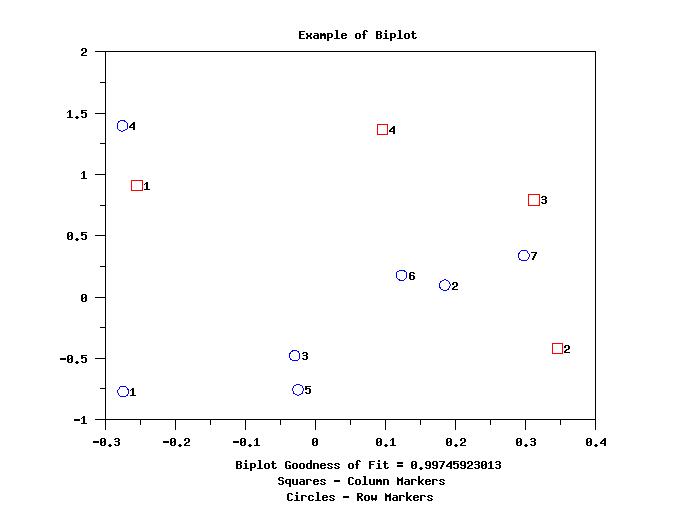

|
BIPLOTName:
The primary purpose of the biplot is to determine what type of model might be appropriate for analyzing the data in the matrix. The biplot method used in Dataplot is based on the singular value factorization of the matrix. The rank 2 singular value factorization leads to the following equation (X is a matrix with n rows and p columns)
where
\( B' = \left( \begin{array}{llcl} V_{11} l_{1}^{1-k} & V_{21} l_{1}^{1-k} & \cdots & V_{p1} l_{1}^{1-k} \\ V_{21} l_{2}^{1-k} & V_{22} l_{2}^{1-k} & \cdots & V_{p2} l_{2}^{1-k} \\ \end{array} \right) \) \( l_1 \ge l_2 \ge \cdots \ge l_p \) are the eigenvalues of X U are the left eigenvectors of X V are the right eigenvectors of X The rank 2 approximation will be useful if the \( l_3 \cdots l_p \) are small relative to the \( l_1 \) and \( l_2 \). The two colums of A are used as coordinates for plotting the n rows (these are referred to as the row markers). Similarly, the two rows of B' are the coordinates for plotting the variables (these are referred to as the column markers). The following values of k are typically used:
To set the value of k, enter the command
The default is 0.5 (for versions prior to 2018/11, the default is 1.0). Values outside the (0,1) interval will be set to the default. It is also common to scale the data by subtracting the column mean. Alternatively, you can subtract the grand mean. To specify the scaling to use, enter
The default is COLUMN MEAN (for versions prior to 2018/11, the default is GRAND MEAN). Although the rank 2 singular value factorization is most commonly used for biplots, the biplot can in fact be based on any rank 2 approximation of the X matrix. However, other rank 2 approximations are not currently supported in Dataplot. A goodness of fit measure for the biplot is
This is the ratio of the sum of the first two eigenvalues to the sum of all the eigenvalues. This value is an indication of how well the rank 2 approximation of X fits the original X matrix. Dataplot saves this goodness of fit statistic in the parameter BIPLOTGF when it executes the BIPLOT command. The primary application of the biplot is as a diagnostic tool. Specifically,
For a disucussion of row linear, column linear, and concurrent models, see the Mandel reference. For a fuller discussion of interpreting and using biplots, see the References section below.
<SUBSET/EXCEPT/FOR qualification> where <m> is a matrix for which the biplot coordinates are to be computed; <y> is an variable where the y coordinates of the biplot values are saved; <x> is an variable where the x coordinates of the biplot values are saved; <tag> is a variable that identifies whether the given row of <y> and <x> is a row marker (<tag> = 1) or a column marker (<tag> = 2); and where the <SUBSET/EXCEPT/FOR qualification> is optional.
In the terminology of Gower, Lubbe, and le Roux, Dataplot generates a 2-dimensional principal components analysis (PCA) asymmetric biplot. Asymmetric implies the rows and columns of the matrix cannot be interchanged. The columns represent continuous variables. Coordinates are generated in 2 dimensions and the rank 2 approximation is based on the singular value factorization.
du Toit, Steyn, and Stumpf (1986), "Graphical Exploratory Data Analysis," Springer-Verlang, 1986, pp. 107-114. Mandel (1995), "Analysis of Two-Way Layouts," Chapman-Hall, pp. 49-53. Gower, Lubbe, Le Roux (2011), "Understanding Biplots", Wiley.
2018/11: Change the default for SET BIPLOT COEFFICIENT 2018/11: Change the default for SET BIPLOT SCALING
. Step 1: Define data
.
. Source: "The Biplot as a Diagnostic Tool for Models of
. Two-Way Tables", Brandu, Gabriel, Technometrics,
. February, 1978.
.
. Data is yeilds of cotton, with rows denoting variety
. and columns denoting center.
.
DIMENSION 100 COLUMNS
READ MATRIX M
1.55 1.26 1.41 1.78
3.39 3.47 2.82 3.89
1.95 1.91 1.74 2.29
10.47 9.12 9.55 17.78
1.45 1.51 1.41 1.70
3.72 3.55 3.09 4.27
4.47 4.07 3.98 4.47
END OF DATA
.
LET P = MATRIX NUMBER OF COLUMNS M
LOOP FOR K = 1 1 P
LET M^K = LOG(M^K)
END OF LOOP
.
. Step 2: Generate the coordinates for the biplot (this is a
. combined row/column marker biplot).
.
LET Y X TAG = BIPLOT M
LET Y2 = Y
LET X2 = -X
.
. Step 3: Now plot the biplot.
.
.
. Step 3a: Iteration 1 will draw row markers as filled
. circle and column markers as filled squares.
.
TITLE Example of Biplot
TITLE OFFSET 2
TITLE CASE AS IS
LABEL CASE ASIS
X1LABEL Biplot Goodness of Fit = ^BIPLOTGF
LEGEND CASE ASIS
LEGEND JUSTIFICATION CENTER
LEGEND 1 Squares - Column Markers
LEGEND 2 Circles - Row Markers
LEGEND 1 COORDINATES 50 7
LEGEND 2 COORDINATES 50 4
.
CHARACTER HW 2.0 1.5 ALL
CHARACTER CIRCLE SQUARE
CHARACTER FILL SOLID ALL
CHARACTER COLOR BLUE RED
LINE BLANK ALL
PLOT Y2 X2 TAG
.
. Step 3b: Now generate row and column ID's
.
LEGEND 1
LEGEND 2
LIMITS FREEZE
PRE-ERASE OFF
CHARACTER OFFSET 1.5 0 ALL
CHARACTER COLOR BLACK ALL
.
LET NTOT = SIZE Y
LET ROWID = SEQUENCE 1 1 NTOT
CHARACTER AUTOMATIC ROWID
PLOT Y2 X2 ROWID SUBSET TAG = 1
PLOT Y2 X2 ROWID SUBSET TAG = 2

|
Privacy
Policy/Security Notice
NIST is an agency of the U.S.
Commerce Department.
Date created: 11/26/2018 | |||||||||||||||||||||||||